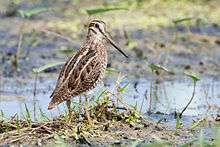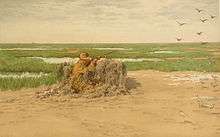Snipe
| Snipe | |
|---|---|
 | |
| Pin-tailed snipe (Gallinago stenura) | |
| Scientific classification | |
| Kingdom: | Animalia |
| Phylum: | Chordata |
| Class: | Aves |
| Order: | Charadriiformes |
| Family: | Scolopacidae |
| Genera | |
A snipe is any of about 26 wading bird species in three genera in the family Scolopacidae. They are characterized by a very long, slender bill and crypsis, or camouflage, plumage. The Gallinago snipes have a nearly worldwide distribution, the Lymnocryptes snipe is restricted to Asia and Europe and the Coenocorypha snipes are found only in the outlying islands of New Zealand. The four species of painted snipe are not closely related to the typical snipes, and are placed in their own family, the Rostratulidae.
Behaviour
Snipes search for invertebrates in the mud with a "sewing-machine" action of their long bills. The sensitivity of the bill is caused by filaments belonging to the fifth pair of nerves, which run almost to the tip and open immediately under the soft cuticle in a series of cells. A similar adaptation is found in sandpipers. They give this portion of the surface of the premaxillaries a honeycomb-like appearance. Through these filaments the bird can sense its food in the mud without seeing it.[1]
Diet
Snipes feed mainly on insect larva. Other invertebrate prey include snails, crustacea, and worms. The snipe's bill allows the very tip to remain closed while the snipe slurps up invertebrates.[2]
Habitat
Snipes can be found in various types of wet marshy settings including bogs and swamps, wet meadows, and along rivers and ponds. Snipes avoid settling in areas with dense vegetation, but rather seek marshy areas with patchy cover to hide from predators.[2]
Hunting

Camouflage may enable snipe to remain undetected by hunters in marshland. If the snipe flies, hunters have difficulty wing-shooting due to the bird's erratic flight pattern. The difficulties involved in hunting snipes gave rise to the term sniper, meaning a hunter highly skilled in marksmanship and camouflaging, which later evolved to mean a sharpshooter or someone who shoots from a concealed location.[3][4]
"Going on a snipe hunt" is a phrase suggesting a fool's errand, or an impossible task. As an American rite of passage, it is often associated with summer camps and groups such as the Boy Scouts.[5]
See also
- Snipe eel
- Snipe (mammal)
Footnotes
- ↑

- 1 2 "Wilson's Snipe, Life History, All About Birds - Cornell Lab of Ornithology".
- ↑ "sniper (n.)". Online Etymology Dictionary. Retrieved 7 January 2017.
- ↑ Palmatier, Robert Allen (1995). Speaking of Animals: A Dictionary of Animal Metaphors. Westport, Connecticut: Greenwood Publishing. p. 357. ISBN 0313294909.
- ↑ Fee, Christopher R.; Webb, Jeffrey B., eds. (2016). American myths, legends, and tall tales : an encyclopedia of American folklore. Santa Barbara: ABC-CLIO. p. 514. ISBN 9781610695671.
External links
| Look up snipe in Wiktionary, the free dictionary. |
| Wikisource has the text of the 1911 Encyclopædia Britannica article Snipe. |
- Snipe videos on the Internet Bird Collection
- http://www.fssbirding.org.uk/snipesonogram.htm